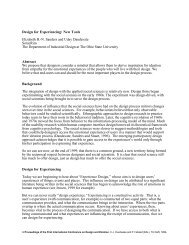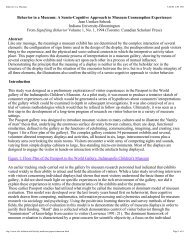: Interface as Content The Construction of Experience - ec(h)o
: Interface as Content The Construction of Experience - ec(h)o
: Interface as Content The Construction of Experience - ec(h)o
Create successful ePaper yourself
Turn your PDF publications into a flip-book with our unique Google optimized e-Paper software.
David Rokeby : Transforming Mirrors3/11/03 4:21 PMhappens quickly, we spent most <strong>of</strong> our time not really sensing our environment, living in a world <strong>of</strong>pre-digested and abstracted memories.This explains our attraction to optical illusions and mind-altering experiences (chemicallyinducedor not). Those moments <strong>of</strong> confusion, where identification and resolution aren’t immediate,give us a fl<strong>as</strong>h <strong>of</strong> the raw experience <strong>of</strong> being. <strong>The</strong>se moments <strong>of</strong> confusion are also the fulcra <strong>of</strong>paradigm shifts. It’s only when our conventional way <strong>of</strong> dealing with things breaks down that w<strong>ec</strong>an adopt another model, another way <strong>of</strong> imagining and experiencing a scenario.<strong>The</strong> adrenaline rush <strong>of</strong> a high-speed video game h<strong>as</strong> something in common with this experience<strong>of</strong> filter-breakdown; the barrage <strong>of</strong> images and the need to act quickly test the limits <strong>of</strong> ourperceptual and responsive systems. But these systems have then added themselves to our internalfilters and they aren’t subj<strong>ec</strong>t to this same sort <strong>of</strong> breakdown. Paradigm shifts in the interface canonly happen through the s<strong>of</strong>tware and hardware development cycle, which is burdened with<strong>ec</strong>onomic considerations and intense industry competition. <strong>The</strong> interface b<strong>ec</strong>omes a hardened andbrittle perceptual exoskeleton which we can’t e<strong>as</strong>ily question or redefine. This b<strong>ec</strong>omesincre<strong>as</strong>ingly problematic <strong>as</strong> the interface b<strong>ec</strong>omes more “transparent” and “intuitive.” At thosedifficult and confusing moments when our way <strong>of</strong> viewing the world needs to change, we may notknow to examine the interface <strong>as</strong> a potential contributor to the problem. For this re<strong>as</strong>on, I believe weneed to develop an interactive literacy. We need to learn, then teach others to critique andunderstand the influences <strong>of</strong> our interfaces <strong>as</strong> we use them.PUNCH AND SCREAMOur interface with reality is not only multi-sensory or multimedia but also “multi-modal.” We cantalk, scream, gesture or punch. We can interpret, analyze or simply enjoy the raw sensation. It’sonly a multi-modal approach with multiple simultaneous levels <strong>of</strong> meaning and communication thatcan properly express that complex experience <strong>of</strong> reality.In 1988, I w<strong>as</strong> invited to exhibit “Very Nervous System” at the Siggraph Art Show. “Interactivity”w<strong>as</strong> just emerging <strong>as</strong> a buzzword and there w<strong>as</strong> a lot <strong>of</strong> scepticism on the floor. Many attendeesentered my installation to “test” it using what I’ve come to call the “First Test <strong>of</strong> Interactivity.” <strong>The</strong> testinvolves determining whether the system will consistently respond identically to identicalmovements. (Note that an intelligent agent will probably fail this test.) <strong>The</strong>y would enter the space,let the sounds created by their entrance fade to silence, and then make a gesture. <strong>The</strong> gesture w<strong>as</strong>an experiment, a question to the space; “What sound will you make?”. <strong>The</strong> resulting sound w<strong>as</strong>noted. S<strong>ec</strong>ond and third gestures were made with the same motivation, and the same sound w<strong>as</strong>produced. After the third repetition, the interactor d<strong>ec</strong>ided that the system w<strong>as</strong> indeed interactive, atwhich point they changed the way they held their body and made a gesture to the space, a sort <strong>of</strong>command: “Make that sound.” <strong>The</strong> command gesture w<strong>as</strong> significantly different from the early“questioning” gestures particularly in terms <strong>of</strong> dynamics, and so the system responded with adifferent sound. I observed a couple <strong>of</strong> people going through this cycle several times before leavingin confusion. <strong>The</strong>ir body had betrayed their motivation.Body movement can be read on two different levels. <strong>The</strong>re is the semantic content <strong>of</strong> the gesture,in which the movement is interpreted symbolically (the “OK” sign or the raised middle finger), andthere is the raw visual experience <strong>of</strong> the gesture, to which my system w<strong>as</strong> responding. <strong>The</strong>questioning and commanding gestures were semantically similar but quite different in terms <strong>of</strong>physical dynamics. More practical interactive interfaces might filter out the involuntary dynamics <strong>of</strong>the gesture, treating them <strong>as</strong> unwanted noise, and focus on the semantic content. In interpersonalhttp://www.interlog.com/~drokeby/experience.htmlPage 6 <strong>of</strong> 15





